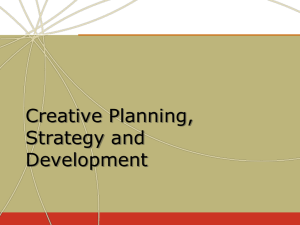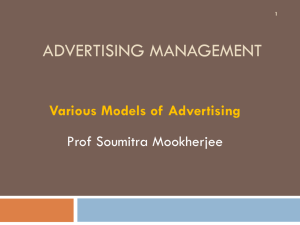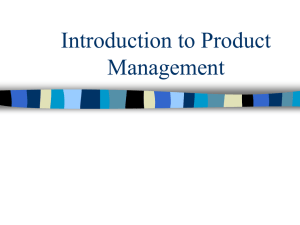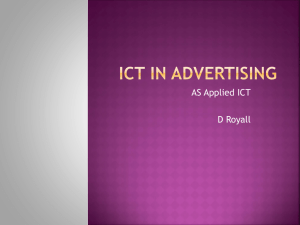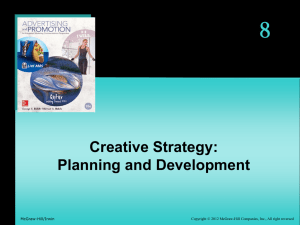Chapter 8
advertisement
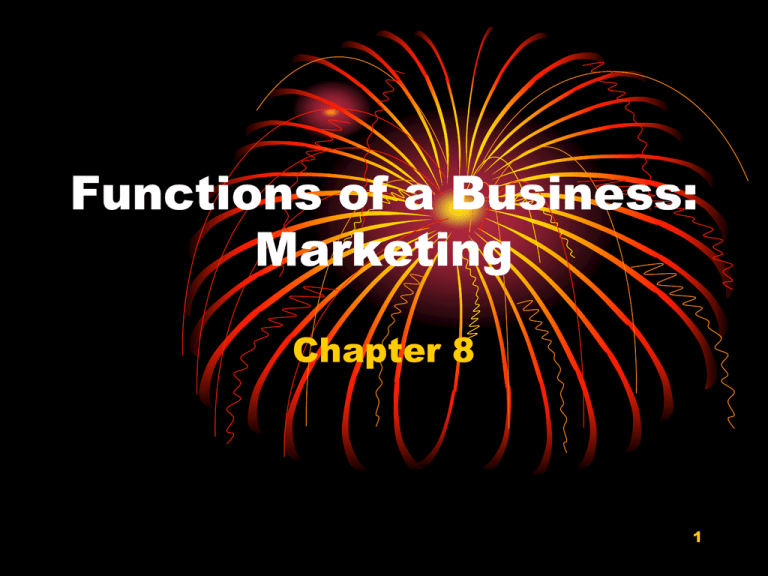
Functions of a Business: Marketing Chapter 8 1 Opening Activity • Describe your favourite advertisiement • Why you like it? • What is your favourite store? • Why do you prefer it to others? • What is your favourite soft drink? Why? 2 Chapter 8: Marketing The Role and Impact of Marketing Marketing is all activities involved in getting goods and services from the businesses that produce them to the consumer. Marketing has two fundamental roles: 1) to sell what a business makes (for example: 2) to manage the brand (for example: ) ) 4 Chapter 8: Marketing The Role and Impact of Marketing • Marketing activities include: • • • • • • research development sales distribution advertising promotion 5 Chapter 8: Marketing The Role and Impact of Marketing Branding Businesses can spend millions of dollars creating an image for products and services with a brand name, logo or trademark, a slogan. 6 Chapter 8: Marketing The Role and Impact of Marketing Branding Brand Name A brand name is a word or group of words a business uses to distinguish its products from that of the competition. Brand names should be distinctive, stand out, and memorable. Activity Link 7 Chapter 8: Marketing The Role and Impact of Marketing Logo or Trademark A logo is a symbol that is associated with the company or product. It can take the following forms: Monogram, visual symbol, abstract symbol. A trademark is a word, symbol, design, or a combination of all three that a business uses to distinguish its goods or services from others. 8 Chapter 8: Marketing The Role and Impact of Marketing Slogan A slogan is a short or catchy advertising phrase associated with a company or product. 9 Chapter 8: Marketing The Role and Impact of Marketing Jingles A jingle is a slogan or vocal line set to an engaging melody mainly used as an advertisement Jingles are designed to be memorable and stick in the mind of the listener. Jingles can be used on TV, Radio and Internet and can be as simple as a singer with a voiceover or a complex customized written piece of music depending on its intended result. History Will Be Made East Side Mario's shortened.flv im loving it.flv 10 Chapter 8: Marketing The Role and Impact of Marketing Brand Identification Everything associated with a product, such as the slogan, name, and logo, must be used consistently to ensure that the brand is always identifiable to the consumer. APPRENTICE CHALLENGE Apprentice Challenge Link Every team needs a sheet of lined paper Place numbers 1-40 along the side Only one sheet per team GOOD LUCK!!! 11 Chapter 8: Marketing The Role and Impact of Marketing The Product Life Cycle Marketing efforts pay off in the form of consumer reaction to the brand. Successful marketing efforts increase brand equity or the value of the brand in the marketplace. The changes in popularity or sales volume of a product over time can be graphed on the product life cycle or style curve. 12 Chapter 8: Marketing The Role and Impact of Marketing Traditional Product Life Cyle 13 Chapter 8: Marketing The Role and Impact of Marketing Go to page 232 in the text to fill in the chart after the diagram in your notes. 14 Chapter 8: Marketing The Role and Impact of Marketing Non-traditional Product Life Cycles Fads •A fad is a product that is extremely popular with a select market for a short time, usually less than a year. •Examples: 15 Chapter 8: Marketing The Role and Impact of Marketing Non-traditional Product Life Cycles Niches •A niche is a section of the market in which a product dominates and into which few competitors enter. •Niche marketers are often left alone because of barriers to entry—the factors that prevent competition from being profitable in a given market. Examples: 16 Chapter 8: Marketing The Role and Impact of Marketing Non-traditional Product Life Cycles Seasonal •Some products are popular during a specific time or season. • Balancing product quantity with seasonal sales is called inventory management. To be left with little seasonal inventory, businesses calculate the amount of product to keep on hand. Examples: 17 Chapter 8: Marketing REVIEW: The Role and Impact of Marketing 1) Definition of Marketing Marketing is all activities (research, development, sales, distribution, advertising, promotion) involved in getting goods and services from the businesses that produce them to the consumer. 2) Two Fundamental Roles to sell what a business makes, to manage the brand 3) Branding brand name, logo or trademark, slogan & jingle. 4) Product Life Cycle traditional – introduction, growth, maturity, decline non traditional – fads, niche, seasonal 18 Chapter 8: Marketing Marketing Concepts Marketing can be divided into two major concepts: 1) The Product Concept which involves the 4 P’s of marketing and 2) The Market Concept which involves the 2 C’s of marketing. Today we will focus on the 4P’s Note the orange and green 19 Chapter 8: Marketing Marketing Concepts The Four P’s of Marketing Product Price Place Promotion A good combination of all four elements, called the marketing mix, translates into an effective campaign. NOTE: I will need to see these concepts put into action in preparing for and actually running your table on business day. 20 Chapter 8: Marketing Marketing Concepts 1. Products and Services The two reasons businesses develop products are because they can and they see a need. The development of good products and services considers a) quality, b) design, c) features, d) benefits and e) product/service mix. 21 Chapter 8: Marketing Marketing Concepts 1. Products and Services (cont’d) a) Quality Improvements made to the quality of a product attracts more customers. For example: 22 Chapter 8: Marketing Marketing Concepts 1.Products and Services (cont’d) b) Design Every product and service has a design component. Consumers will often buy one product over another because of the way it looks. For example: 23 Chapter 8: Marketing Marketing Concepts 1.Products and Services continued c) Features Product developers consider the features used, such as the materials, scent, size, or the taste, when constructing a new product. Service providers outline or detail what they do best. For example: 24 Chapter 8: Marketing Marketing Concepts 1. Product and Service (cont’d) d) Benefits Consumers buy products and services for a particular purpose. Businesses need to make consumers aware of the advantages of a product to be motivated to buy it. For example: Bounty absorbs more liquid than its competitors. This is emphasized in its promotions. 25 Chapter 8: Marketing Marketing Concepts 1. Product and Service (cont’d) e) The Product/Service Mix A retail store provides services and a service business sells a product. The resulting product/service mix can increase sales to existing customers and attract new ones. For example: 26 Your Turn You have 10 minutes to compare RIM’s Blackberry Bold and Apple’s iPhone with a partner a) b) c) d) e) Quality Design Features Benefits Product/service mix Chapter 8: Marketing Marketing Concepts 2. Price Prices for products must be set with care to ensure their success. Today consumers are very price conscious and look for competitive prices at other stores or on the Internet. Businesses need to be price sensitive and look at their competitors’ prices for the same products. 28 Chapter 8: Marketing Marketing Concepts 3. Place (Channels of Distribution) Channels of distribution are the paths of ownership that goods follow as they pass from the producer or manufacturer to the consumer. The three types of channels of distribution are 1) direct, 2) indirect, 3) specialty. 29 Chapter 8: Marketing Marketing Concepts 3.Place (Channels of Distribution) cont’d Direct Channels Direct channels of distribution connect the consumers to the producers of the goods or services. This is also referred to as the maker-user relationship. For example: 30 Chapter 8: Marketing Marketing Concepts 3.Place (Channels of Distribution) cont’d Indirect Channels Indirect channels of distribution have one or more intermediaries who import products (importers), wholesale goods (wholesalers), or retail products (retailers). For example: Importers Wholesalers Retailers 31 Chapter 8: Marketing Marketing Concepts 3. Place (Channels of Distribution) cont’d Specialty Channels A specialty channel of distribution is an indirect way to distribute products by using vending machines, telemarketing, catalogue sales, e-commerce, and door-to-door sales. No retail store is involved. 32 Chapter 8: Marketing Marketing Concepts 4. Promotion Promotion is an attempt to sell a product. Sales promotion encourages consumers to buy products by using: coupons contests premiums samples special events Your Turn: Fill in the chart in your notes using pages 247-8 Can you bring in some actual examples tomorrow? (no computer generated copies) for BB’s. 33 Chapter 8: Marketing Marketing Concepts The Two C’s of Marketing The marketing department must consider two major external factors: 1) the competition and 2) the consumer. Open text to page 249 and let’s read pages 249-251 “The Competitive Market” Continue with next note 34 Chapter 8: Marketing Marketing Concepts The Competitive Market The competitive market refers to the sellers of a specific product, and is often expressed in terms of the total dollars spent annually on the product. The percentage of the market that a company or brand has is called its market share. A market segment is a part of the overall market with similar characteristics. 35 Chapter 8: Marketing Marketing Concepts Competition among Products Indirect competition means products or services are not directly related to each other. For example: Products that are similar to one another are called direct competition. For example: 36 Chapter 8: Marketing Marketing Concepts The Consumer Market In their effort to be competitive, businesses study and target the consumer market, the potential users of a product or service. These consumers can be identified by demographics and lifestyle. . 37 Chapter 8: Marketing Marketing Concepts The Consumer Market cont’d Demographics Demographics is the study of obvious characteristics that categorize human beings. Some examples of demographics include the following: • age • gender • family lifestyle • income level • ethnicity and culture Lifestyle Lifestyle is the way people live, including their values, beliefs, and motivations. 38 Chapter 8: Marketing Marketing Concepts 1) Go to pages 247-248 to fill in the Promotion chart examples in your notes 2) Go to pages 252-254 to fill in the demographics chart 3) Show me your completed work. 4) Work on marketing project with your group 39 Chapter 8: Marketing Advertising Creating Good Advertising Good advertisements sell products by making the consumer remember the brand name of their products or services. The four standard rules for creating good advertising are summarized as follows: 1. Attract attention – develop a good headline 2. Gain interest – make people want to read, watch, or listen 3. Build desire – help the customer want your product 4. Get action – always ask for the sale AIDA - Magazine advertisement assignment 40 Chapter 8: Marketing Advertising Types of Advertising Advertising is the paid-for promotion of a businesses’ goods and services using a variety of mass media to target a market. Common advertising classifications include p.258 • • • • direct-to-home out-of-home radio television • newspapers • magazines • Internet 41 Chapter 8: Marketing Advertising Comparing Types of Advertising Advertisers use the following categories to help them select which media to use for a certain product promotion. These eight categories are • • • • reach frequency selectivity durability • • • • lead-time mechanical requirements clutter cost 42 Chapter 8: Marketing Marketing Research Market research is the collection and analysis of information that identifies specific groups of consumers who would use a particular product or service. Types of Marketing Research Marketers use different types of research depending on what information is needed, how it will be collected, and what will be done with the final information after it is analyzed. The following is a list of the most common types of research used by marketers: • consumer research • competitive research • market research • product research • motivation research • advertising research • pricing research 43 Chapter 8: Marketing Marketing Research Marketing Research Tools Marketing research relies on secondary and primary data. Secondary Data Secondary data is information collected by others. Secondary data can be collected from Web sites, databases, periodicals, indexes, and professionally prepared marketing research reports. Primary Data Primary data refers to current information that is collected and analyzed for a specific purpose. Methods include • observation • test marketing • focus groups • internal information sources • surveys 44 Grade 11 • Consider taking Marketing in grade 11, BMI3C • The course focuses on 4 P’s of marketing • It will be a combination hands-on and text learning 45



